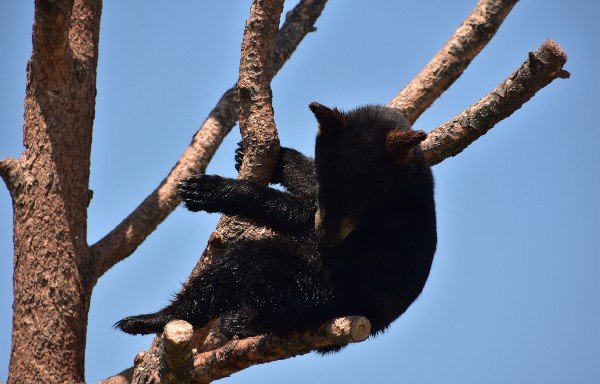The elegance of black bears is captivating, whether they are a familiar sight in your surroundings or you’re eagerly anticipating an encounter in a different habitat. Knowing their hibernation schedule can significantly enhance your chances of spotting these remarkable mammals.
Black bears typically become active in the spring and summer, presenting a prime opportunity to witness them in their natural element. During this period, these sizable creatures dedicate their days to consuming substantial amounts of food. Remarkably, it’s not uncommon for a bear to devour around 20,000 calories in a single day. To put that in perspective, the average human consumes about 2,000 calories. This voracious appetite spans a diverse menu of plants, grasses, berries, acorns, insects, honey, birdseed, and scavenged garbage.
While this eating pattern might seem extravagant, it’s important to note that black bears don’t sustain this level of consumption on a daily basis. Instead, they engage in this feeding frenzy to amass fat reserves in preparation for hibernation.
As the weather turns colder and the availability of food diminishes, black bears retreat to their winter dens. The duration of their hibernation varies according to gender. Male bears usually begin entering their dens around mid-December, reawakening in mid-March as temperatures rise. Female bears, on the other hand, undergo an extended hibernation period. This is especially true for those who give birth during the winter months. These mothers remain in their dens for an extended period to care for their cubs. Their hibernation initiates in late November, and they may emerge around mid-April, having fulfilled their maternal responsibilities.
Understanding Bear Hibernation
The concept of bear hibernation is a subject of debate among scientists. The term “lethargy” or “torpor” is often used to describe their hibernation. Unlike “true” hibernators such as rodents and bats, which experience an abrupt drop in body temperature and a near-zero metabolic rate, black bears exhibit unique behaviors. They remain relatively alert during hibernation and can even sense the presence of potential threats. Their ability to rouse themselves quickly serves as a defense mechanism.
Unlike typical “true” hibernators, black bears refrain from eating, drinking, urinating, or defecating throughout the hibernation period. It’s astonishing that they may lose up to 30% of their body mass during this time. Strikingly, some bears may actually gain muscle mass by hibernation. This is attributed to their ability to use nitrogen in urea for protein synthesis, which sustains muscle and organ mass. Additionally, black bears possess the capability to recycle their own water, effectively circumventing dehydration and kidney issues during their dormant state.
Contact Us Today
Black bears thrive in the warmer months, capitalizing on a rich feast before their hibernation phase. To relish a bear encounter before they embark on their dormancy, consider a visit to Yellowstone Bear World. Our drive-thru wildlife park guarantees an array of engaging activities, offering not only bear sightings but also other captivating wildlife experiences. With our daily opening hours, we provide a delightful opportunity to connect with nature. Reach out to us at (208) 359-9688 or through our online channels to explore more about Yellowstone Bear World.





